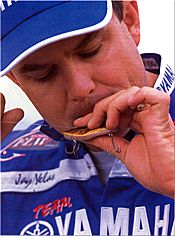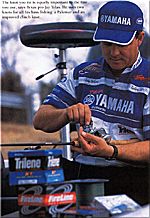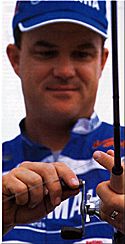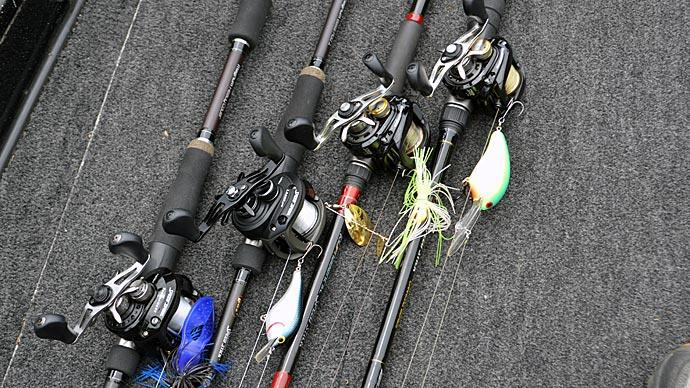| Loopy |
|
Yelas says that loops and the tangles they create on spinning reels are just part of the equation, but there are ways to minimize the number of "bird's nests" you encounter when fishing. First, ensure the mono goes on the reel the same way it comes off the spool when you load it with fresh line. Another tip? "Instead of using your reel handle to close your bail, use your hand. That prevents that loose line from forming a loop when the bail turns as it closes," he says. A third trick is to give the line a light tug just above the reel after the bail closes. That pulls out any loops that may have formed. It's a ritual that can be tough to follow, but once you learn to do it after every cast, you'll stay loop-free. |

Yamaha pro Jay Yelas has to dig deep to recall the last fish that broke his line. It was a 7-pounder, he remembers, that ate a tiny crankbait tied to 12-pound test Trilene XT. The big bass took the lure deep - common for big bass and small lures - and the line rubbed across the fish's rough lips during the tussle, separating Yelas from that all-important tournament bass. It was just one of those freak events that happened on rare occasions for Yelas. For other anglers, however, a broken line is nothing more than an annoying yet familiar part of fishing.
"My co-angler partners are constantly losing fish because their line broke. So there's no excuse for breaking off a bass," says the respected pro.
Nothing, besides the actual lures a bass angler uses, is more critical than that fine thread that attaches the bait to the rod and reel. Everything rides on the line.
Yelas uses four lines for all his bass fishing: Trilene XT, Berkley Sensation, FireLine, and Berkley Trilene 100% Fluorocarbon. Like any bass angler who has to boat every bass he hooks to make a living, Yelas is adamant about using the right line for specific applications.
Ties That Bind
The first line of defense against broken line and lost fish is constant vigilance over the line itself. Yelas reties his lures throughout the day, so often that his partners often comment on his seemingly obsessive habit.
"Any time there is the slightest nick or a fray, I'll cut off 3 or 4 feet of line above the nick and retie my lure," he says. "If I catch a big bass, I'll retie. I don't take any chances."
When he snips off and reties his lures, Yelas uses one of two quick, simple knots: an improved clinch or a Palomar. Either knot works fine for standard monofilament line, but when he uses fluorocarbon, he says an improved clinch knot is much less likely to break.
Super Line?
On the other hand, a Palomar knot won't slip when used with FireLine. A clinch knot will. When so-called "super lines" hit the market a decade ago, anglers rushed out in droves, bought spools of these new products, and immediately stripped the monofilament off their reels and replaced it with products like FireLine and Spider Wire. Unfortunately, their expectations were often met with resounding disappointment. Many of those first to try the lines revolted and switched back to monofilament, cursing the day they switched.

"I use FireLine for about 15 percent o my fishing. A golfer doesn't use his nine iron for everything, and bass anglers shouldn't try to use a single line for every type of fishing. FireLine is not a substitute for monofilament," Yelas says.
Although standard mono factors into the bulk of his bass fishing, the Texas pro favors FireLine for a few pinpoint applications that demand low stretch and high breaking strength. A prime example was when he fished an FLW Tour event on Lake Okeechobee. The lake had been low for years, and dense vegetation sprang up in dry sections of the lakebed, but the water came back up, and the bass invaded that flooded vegetation.
"It was like fishing in a thick hayfield," he recalls. "There was no room for fighting the fish. If you didn't winch him up out of that cover, he would just dig down and bury himself. It took me less than five seconds between when I got a bite and when I got a fish in the boat. That's where FireLine pays off."
Yelas also likes to use it in heavy grass, thick brush, and timber in clear water, adding that the line tends to blend in with all the other cover. In addition, the low stretch allows him to make long casts and still have enough hook-setting power to stick and land fish.
"FireLine is also great for fishing buzzbaits around thick lily pads. I'll use it with topwaters when I need to make real long casts over open water," he adds.
Monofilament
Monofilament, made from nylon, still has a place for Yelas.
"I use mono for just about all my topwater fishing, spinnerbaits, and shallow crankbait fishing. It's perfect for any short-range fishing, except those rare exceptions when the cover is so thick I need to use FireLine," he says.
The monofilament he uses is Berkley Sensation, which has somewhat less stretch and more sensitivity than standard mono. It accounts for about 15 percent of all his applications. Although the differences are subtle and most recreational anglers probably wouldn't notice, Yelas says Sensation is ideal for crankbaiting in open water and casting Texas-rigged plastic worms.

Fluorocarbons
So what's the next big thing? Fluorocarbons. Made from the same materials as Teflon (fluorine and carbon), these lines offer the advantage of near-invisibility underwater, a critical factor in clear reservoir fishing applications. Still, Yelas only considers fluorocarbon one more tool in his bass fishing repository.
It comes in a variety of strengths and can be used for a wide variety of applications. Yelas uses Trilene 100% Fluorocarbon for about 60 percent of all his bass fishing and sticks with lines between 12- and 25-pound test.
"I'd say the number one reason my partners lose so many fish is that they are using line that's too light for the job. When I'm using 25-pound test, my partners probably use 14, and they think they are using heavy line. So I always tell people to err on the heavy side when fishing heavy cover and that it's probably better to error on the light side when they fish clear, open water," he says.
Yelas typically uses line no thinner than 20-pound test when he does fish heavy cover, even when pitching in clear water. Then, he bumps his line up to 25-pound test for the heaviest wood cover. Crankbaits work best on 12- or 14-pound test line. That thinner diameter helps the bait get down a little deeper.
"If I'm fishing light lures on a spinning rod in clear water, like drop-shot rigs or tubes, for instance, then I'm going to use 6- or 8-pound test fluorocarbon. So it's perfect for that," he says. In addition, Fluorocarbon line has about half the stretch of mono and more sensitivity, making it ideal for the long casts necessary in clear water.
When To Strip
How often Yelas changes his line depends on the situation. Before tournaments, he strips all of his reels and loads the new line on each. After that, he'll strip a reel only if he used a particular outfit frequently or around heavy, abrasive cover.
"If I'm fishing open water, I'll cut 6 or 8 feet off the end and go from there. I also inspect my line for kinks and nicks, particularly if I backlashed a baitcaster. Backlashes can damage monofilament, so you need to be careful about that," he says.
But what about recreational anglers - the ones who fish once a week or less and who can't afford a new spool of line every time they hit their favorite bass water? Yelas figures changing line every two or three months is adequate, but that depends on the fishing the line was used for. So if you have doubts, replace your line.
"Just remember, making the wrong choice about the line you use or how often you change it may cost you a fish of a lifetime," he warns.
Content provided by Bass Fishing Magazine, the official publication of FLW Outdoors




